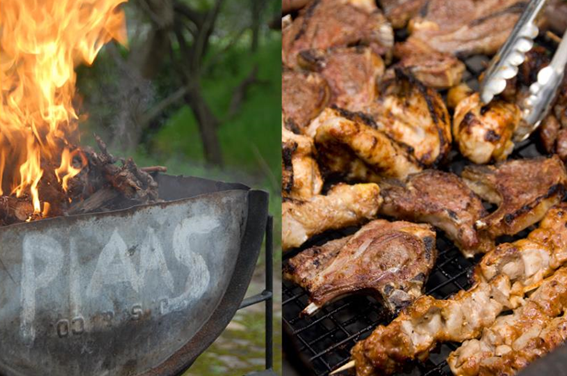
CUE THE BRAAI
To braai or not to braai? That is definitely NOT the question asked in many a South African household. The question is more likely to be WHAT are we braai-ing? For that produces endless possibilities and is something the average South African male enjoys discussing almost as much as the game watched that weekend.
Braai, pronounced ‘bry’ like ‘fry’ is a rite of passage that most South African boys undertake. My husband remembers Boy Scout meets on Fridays where each little boy was handed a chop and a length of boerewors (sausage) and the excitement of making a fire and braai-ing the meat, then devouring the charred result with gusto.
My father is an impatient engineer who would chop his wood up small, light the fire at noon and we would be eating at 1 o’clock. That is highly irregular behaviour, most braai-ers enjoy the steps involved in making the braai, much more than actually eating the end result.
Firstly, we use wood, never gas. But the type of wood is also a talking point. ‘Wingerd stompies’ (vineyard branches) are supposed to be excellent, but that says more about the fact that you own a vineyard, or know someone with a vineyard, than the quality of the wood. Slow burning ‘kameeldoring’ (camel thorn) or ‘rooikrans’ (acacia) is often recommended because it means the braai-er can temper his coals to just the right heat and keep it there for the desired length of time.
Then we like to ponder on what we will braai. The simplest braai meat for the beginner is ‘tjops and wors’ which translates to lamb chops (or cutlets) and ‘boerewors’ or sausage made with either lamb, beef or pork and often spiced with coriander. After that we progress to pork chops and chicken which usually need a marinade and longer, slower cooking; and then we get to sosaties or kebabs steeped in a delicious sweet and sour brew made with vinegar, dried apricots, onions and garlic.
Fish and seafood braais are also ‘de rigeur’ amongst the locals. Nothing beats a braai-ed snoek with a lemon and apricot glaze served with baked sweet potatoes; or perhaps a fresh crayfish on the coals or boiled in a pot of fresh sea water.
Ooh, but now I am straying into ‘potjie’ territory. A ‘potjie’ is a large, 3-legged cast iron pot that is plonked over slow coals and contains a simmering mixture of meat and vegetables and usually a generous quantity of noble late harvest or port.
Then there are the ‘by-kosse’ or side dishes which can range from crusty bread to baked potatoes or a crisp green salad. These are the basics but any self-respecting braai wife will have an arsenal of recipes up her sleeve with which to serve when the meat is (finally) ready.
Braaing can take quite a long time, depending on the wood, the type of meat and the level of chatter; and is always accompanied by a few glasses of wine, if not to splash on the fire to douse the odd errant flame, to lubricate the marinade or top up the potjie, but to consume as you solve the world’s issues or debate the merits of your favourite rugby or soccer team. But make sure to pace yourself, or you will be toasted before the meat is roasted!

For more on braai-ing take a look at the e-Book called Cape Wine Braai Masters published by WOSA and on the website http://www.wosa.co.za/Multimedia/Brochures/
or source a hard copy from Sunbird Publishers http://www.jonathanball.co.za/index.php/component/virtuemart/braai-masters-of-the-cape-winelands-detail?Itemid=13
-Julia Moore